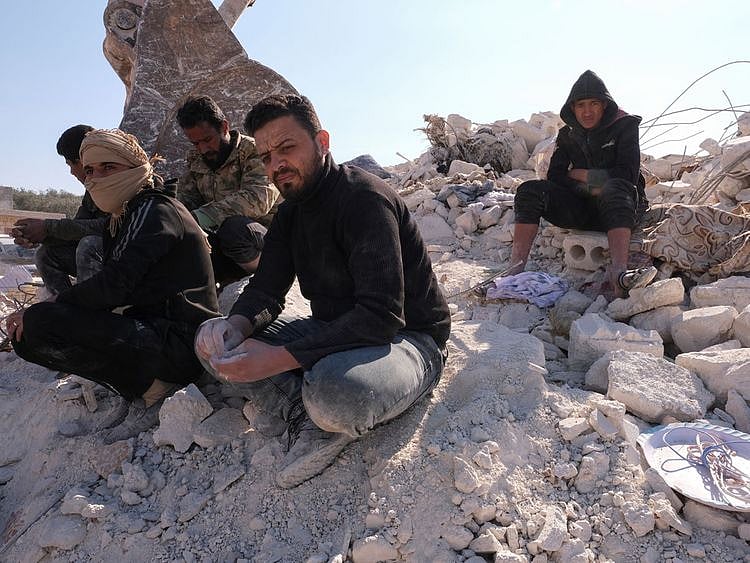Devastating quake in Turkey, Syria shows power of Nature’s fury
Earthquakes render humans helpless but in the midst of this helplessness, miracles happen

Whenever a human community, in whatever part of the world that community might be found, is left harrowed and beaten in the wake of a deadly natural disaster, our sense of common humanity kicks in and we rush to lend a helping hand, leaving our political, cultural and racial differences at the door.
Images of the widespread devastation and of the unspeakable suffering endured by innocent folks were apocalyptic: Millions displaced. Hundreds of thousands sleeping in the open or in makeshift tents in sub-zero cold. Parents parted from their children.
Rescue workers frantically digging for survivors. Thousands of residential buildings destroyed, many with the floors toppling on themselves, bringing all their weight on the floor below, in what is known as a pancake collapse — all with bodies buried underneath.
Also Read
Turkey: Woman rescued from rubble after 203 hours, 3 others after 198 hours after quakeOn visiting comets, collapsing stars and bumbling humansTurkey-Syria earthquake: Emirati rescue team saves two young men trapped in rubble for nine daysTurkey quake Europe’s worst natural disaster in ‘a century’: WHOAnd an unimaginable 40,000 dead — though Martin Griffiths, the United Nations relief coordinator on the ground, claimed that, sadly, after the dust had settled and a full tally had been taken, the toll is likely to exceed 100,000.
“I think it is difficult to estimate precisely (what the final figure might be) before we get under the rubble”, he said on Sunday. “This is nature striking in a really harsh way”.
History of quakes
And nature has been hitting countries in the region very harshly since antiquity.
The earthquake that hit Beirut in 551 killed roughly 30,000 people — a lot of people in those days — and triggered a tsunami that sank ships and flooded cities along the Mediterranean as far south as the then Phoenician city of Acre.
The quake was so powerful in magnitude that it was felt in Antioch, a city in southcentral Turkey then under Byzantine rule that itself had endured the ravages of an earthquake 25 years earlier that caused a staggering 250,000 deaths, though many of the deaths were attributed to fires ignited by the quake.
And roughly three centuries later, on the night of Dec. 27, in the year 856, Damghan, a city in norther Iran, became the epicentre of a powerful quake that destroyed the city’s fortified walls and killed around 200,000 of its residents.
And in 1033, the Jordan Valley in Palestine became another epicentre of a quake that killed 70,000 people — again, not a mean figure, given the sparse density of the population at the time — and spread in concentric circles to Nablus, Jericho and Hebron, then went West to the twin cities of Haifa and Acre.
Finally, five years short of a century later, in 1138, the mother of all quakes in the region hit the ancient Syrian city of Aleppo, where as many as 230,000 people perished.
The fury of nature
History (whose credo is that the shape of man’s destiny lies within man’s ability to chart it) has blessed the Middle East with plenitude of radiant civilisations, whereas nature (whose intentions remain unfathomable) has all too often being harsh.
No one imagines that nature has singled us out, in this little region we inhabit on this planet, to punish, because, say. well, it doesn’t like the colour of our eyes, Nature does not discriminate. It has hit at humans everywhere around the world — and humans have kept records of the catastrophes it has wrought on them for the last 4,000 years.
Take the deadliest earthquake ever recorded in human history, known to historians and geologists alike as the Jianjing Great Earthquake, that struck the province of Shaanxi in 1556, killing an estimated 830,000 people — surely a tragedy whose monumental scale of suffering no one could wrap their head around.
Horror unfolding on television
And take the second deadliest, one we all remember because we saw the horror of it unfold on our television screens, in real time, leaving us, one and all, shaken to and at our core.
That, you will recall, was the earthquake, coupled with a tsunami along the shore of the Indian Ocean, that, on Boxing Day in 2004, ended up killing 230,000 people across Indonesia, Thailand, Sri Lanka and India.
Earthquakes render humans impotent to act, helpless in the face of nature’s fury.
But in the midst of this helplessness miracles happen.
By Monday, with hopes of finding more people alive fading, rescue efforts were set to end. But wait. On the morning of that day, a 13-year-old boy was found alive under the rubble of a collapsed building in a small Turkish town — a full week after the quake, or a full 182 hours.
People everywhere, including this columnist, were unequivocal in declaring his survival a miracle. And, come now, weren’t you?
Fawaz Turki is a noted journalist, academic and author based in Washington. He is the author of The Disinherited: Journal of a Palestinian Exile.
Sign up for the Daily Briefing
Get the latest news and updates straight to your inbox
Network Links
GN StoreDownload our app
© Al Nisr Publishing LLC 2025. All rights reserved.